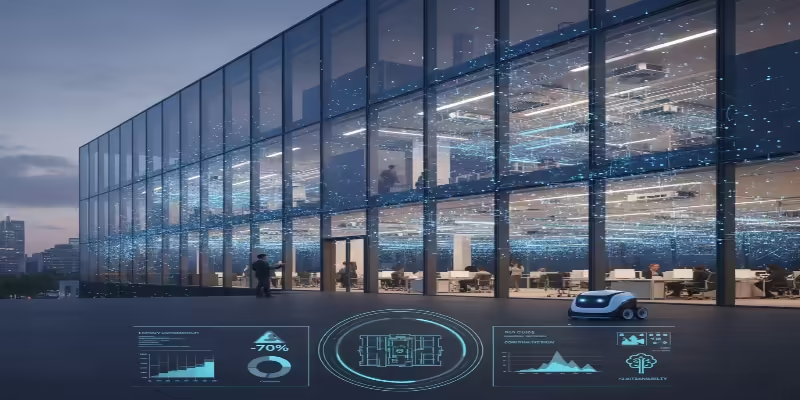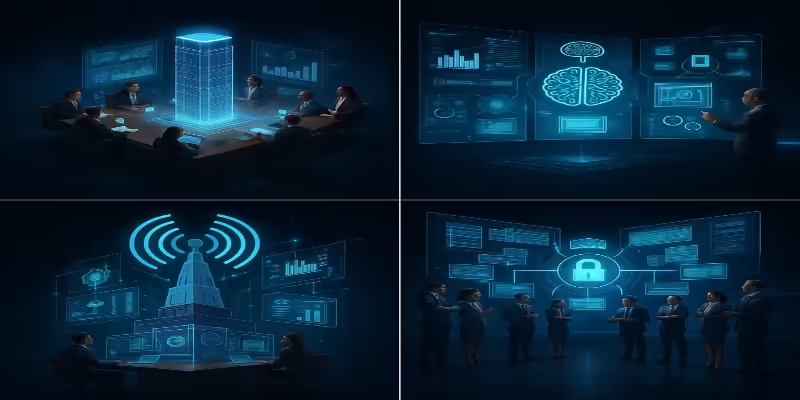The Development of IoT-Powered Property Management
Property management mainly revolved around the operations of the buildings, the satisfaction of the tenants, and the profitability of the assets. However, the scenario is completely different in 2025. The Internet of Things (IoT), which is Big Data in real estate, has changed the concept of static buildings, turning them into living, responsive environments.
IoT property management is no longer a concept of the distant future, as it has become the industry standard. A MarketsandMarkets report says that the global IoT in the real estate market will be worth $133 billion by 2028, with a CAGR of 15.2%. The growth at such a rapid pace is causing the property managers, investors, and developers to rethink efficiency, maintenance, and tenant experience.
This blog is about how smart building technology and predictive maintenance analytics are reshaping property management from being a management of traditional assets into intelligent ecosystems that learn, adapt, and thrive.
Understanding IoT in Property Management
The Internet of Things (IoT) is essentially a group of interconnected devices – for example, sensors, cameras, HVAC systems, lighting controls, etc. – that interact and exchange data via the internet.
In property management, these gadgets gather and evaluate up-to-the-minute data about the performance of the building, occupancy, and even the atmosphere. Such information enables property managers to energize their decision-making process, use energy in an optimal way, and foresee maintenance issues long before they make a mess.
Real Example: Smart Sensors at The Edge, Amsterdam

The Edge in Amsterdam, a building that is frequently referred to as the smartest one in the world,d is monitored by more than 28,000 IoT sensors that check occupancy, lighting, temperature, and energy consumption. Thanks to this network, the facilities can automatically change the conditions to the requirements of the tenants; thus, the energy waste is minimized by almost 70%.
That is IoT property management capable of doing such a power on its own; the intelligent systems are always there for the customer’s comfort, efficiency, and sustainability.
Big Data in Real Estate: The Foundation of Smart Decisions

While IoT is the source of the sensors and devices, Big Data is what brings the intelligence. Today, every connected building is a source of enormous data streams daily. Apart from the air quality readings and energy consumption, there are also maintenance logs and tenant interactions.
Property managers, through Big Data in Real Estate, become capable of collecting insights that were incomparably difficult to capture by hand. This facilitates them to:
Study tenant behaviour for improving satisfaction and loyalty.
Foresee maintenance requirements via data-driven insights.
Properly use the space by knowing traffic and usage patterns.
Lower operational costs by means of real-time energy management.
As an example, Cushman & Wakefield reported that the use of IoT and Big Data had led to a 25% cut in building operating expenses across their managed assets.
With IoT Property Management, the choices that were formerly the result of an educated guess are now supported by analytics and automation.
Smart Building Technology: Making Properties Intelligent
Smart building technology is a perfect example of the merging of three pillars: automation, analytics, and sustainability. Such systems implement IoT devices for decision-making in real-time, which eventually leads to an enhanced performance of the building.
Smart Building Technology Powered by Key Innovations:
1. Automated Energy Management
IoT-enabled HVAC systems, lighting controls, and smart thermostats are capable of self-adjusting as they get input data from occupancy levels and weather conditions. Wastage of energy is minimized through such measures, while the comfort is not compromised.
Example: According to a study by Johnson Controls, smart HVAC systems are able to reduce energy consumption by as much as 30% in commercial buildings.
2. Environmental Monitoring
The metering devices for air quality, humidity, and temperature not only serve as an aid but also ensure that the set health and safety standards are complied with. The importance of this feature has increased considerably since the pandemic and is the main factor for the quality of indoor air.
3. Intelligent Access Control
Access to buildings has been raised to the next level with smart locks and facial recognition systems. The property managers can keep an eye on entry logs from a distance, which is beneficial both in terms of convenience and safety.
4. Integrated Building Systems
Through the use of smart buildings, digital lights, HVAC, fire alarms, and security systems are brought together in one controlling board – hence, control and transparency to the fullest extent are provided.
The use of smart building technology empowers property managers not only to oversee entire portfolios from a distance but also to perform waste reduction and, at the same time, enhance tenant well-being.
Predictive Maintenance Analytics: Prevent Problems Before They Happen
In the past, property management maintenance was mostly reactive when something broke, you went ahead and fixed it. However, due to predictive maintenance analytics, property care is gradually becoming proactive.
Explanation of Predictive Maintenance
IoT sensors are always on, and they are collecting performance data from elevators, HVAC systems, plumbing, and other infrastructures. Machine learning algorithms then analyze this data to find anomalies – small deviations that indicate possible failure.
Thanks to this technology, property managers can make repair appointments in advance of breakdowns, thus they can reduce the time when the system is out of use and avoid costly emergencies.
Example from the Real World: CBRE’s Predictive Facilities Management
CBRE, the global real estate company, has adopted predictive maintenance through the use of AI and IoT sensors in the facilities it manages worldwide. The outcome? Maintenance costs were cut by 15% and the equipment downtime was reduced by 35%.
Primary Benefits of Predictive Maintenance Analytics:
Prompt detection of issues that could later turn into major repairs
Less equipment downtime and longer asset lifespan
Decreased maintenance costs and the Onset of tenant satisfaction
More accurate budgeting and resource allocation
Predictive maintenance is possibly the most significant IoT property management innovation; thus, it is accompanied by both economic and operational advantages.
IoT in Residential Property Management
The advantages of the Internet of Things are not limited to commercial buildings only. Residential communities have shown a lot of energy and interest in bringing these technologies into their way of life to make the residents more comfortable and safer.
Currently, intelligent apartments are equipped with IoT-based security systems, climate control, and voice-activated lighting. The property managers are allowed to check water leaks, energy consumption, and indoor air quality from a distance.
In the case of multifamily housing, the usage of smart access and digital concierge facilities makes the tenant experience more enjoyable. A 2024 Statista report reveals that 60% of new apartment developments in the U.S. are currently equipped with integrated smart systems, which is 20% more than in 2020.
Illustrations of IoT in Residential Properties:
The use of smart thermostats results in energy bill savings of up to 25%.
Leak detectors recognizing water damage are though it has not yet widely spread.
Smart security systems enabling real-time camera access for residents.
Automated maintenance requests are generated by sensor data.
The amalgamation of IoT property management with the residential communities is like a triple-win situation; it escalates property worth, enhances tenant loyalty, and enables eco-friendly living.
Sustainability and Energy Efficiency: A Core Focus
Sustainability is arguably one of the key features of real estate management in the present age. Governments and investors are driving the change through their demands for eco-friendly practices, and IoT is the main enabler of this transformation.
How IoT enhances Green Building
Smart Lighting: Automated LED systems that are adjustable based on presence and natural light.
Energy Tracking: The main source of data is real-time, which thus allows continuous energy audits.
Water Conservation: IoT-enabled irrigation systems that use water most efficiently.
Carbon Monitoring: Sensors help track CO₂ levels to ensure adherence to green certifications.
Deloitte's report on smart buildings shows that the overall energy consumption of a building can be cut by half the same that carbon efficiency can be increased significantly – two of the main factors for companies that are committed to ESG (Environmental, Social, and Governance) goals.
Using smart building technology together with big data in real estate, developers and managers can achieve the same level of profitability while being environmentally responsible.
Challenges in Adopting IoT for Property Management

Although IoT offers enormous possibilities, managing properties through IoT comes with a few problems, such as:
1. Cybersecurity Risks
The main issues of data privacy and network security arise from the fact that there are thousands of interconnected devices. Managers of buildings have to ensure that they are using encrypted communication and secure cloud platforms.
2. High Initial Costs
Credit Smart building technology is the cause of the need for a considerable amount of money to be put up front for infrastructural and training purposes.
3. Data Overload
The large volumes of IoT data can only be handled through the use of strong analytics tools. If data is not managed properly, the important pieces of information may be lost.
4. Integration Complexity
In most cases, integration of legacy systems with new IoT platforms is not straightforward, and thus, it is difficult to achieve full automation.
Anyhow, the problems mentioned above are gradually being resolved due to standardization, better interoperability, and the development of AI-based management platforms.
The Future of IoT Property Management
 In the future, IoT property management is not only going to be very different but also be fully automated and environmentally friendly. Some of the upcoming trends are:
In the future, IoT property management is not only going to be very different but also be fully automated and environmentally friendly. Some of the upcoming trends are:
Digital Twins: A digital version of a building that can show the current working and even predict the future of the building.
Blockchain Integration: Making sure that there is transparency and security in the exchange of IoT data.
AI-Driven Asset Optimization: Machine learning is used to make building systems automatically adjust to the most efficient level.
Edge Computing: Local processing of IoT data without the need for a central server to reduce the time taken for the data to arrive and to increase security.
5G Connectivity: Allowing the real-time monitoring and control to be done easily for the networks of large properties.
By 2030, there will be more than 75 billion IoT devices connected worldwide, as per Statista, and quite a few of these devices will be in the real estate sector, which will be the major beneficiary in the area of IoT.
Conclusion: The Intelligent Future of Property Management
The use of IoT to manage properties has transformed the entire field in a way that is quite revolutionary. A modern property manager who is empowered by Big Data in Real Estate to make smarter decisions enjoys more control than ever with the aid of Smart Building Technology that facilitates real-time automation and Predictive Maintenance Analytics that help avoid costly breakdowns.
Far from being merely a device, IoT is the basis for a connected, data-driven, and environmentally friendly real estate future.
In ten years from now, property management will no longer be about reacting to tenant demands; rather, it will be about foreseeing them. And with the use of IoT in property management, that smart future is already happening.